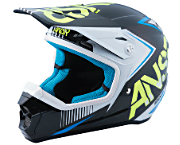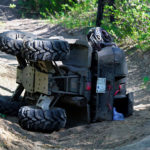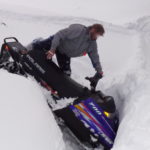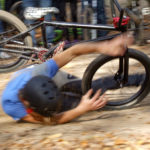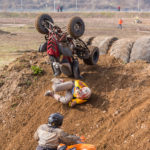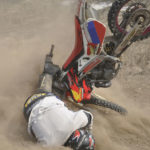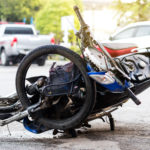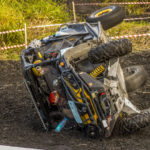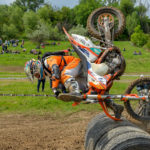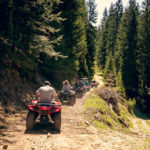
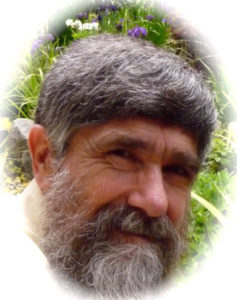
ATV Court-Qualified Expert Witness Bill Uhl
Bill Uhl has completed over 75 legal cases as an Expert Witness.
He has worked for both plaintiffs and defendants,
being deposed, writing reports and providing trial testimony.
Uhl has been court qualified as a safety training expert for ATVs (all-terrain vehicles), UTVs (side by sides), motorcycle dirt bikes, snowmobiles, dual sport bikes and some street bike and mountain bicycle issues. He served as Expert Witness or Consultant in over 75 cases. Attorney references are available on request.
Uhl’s expertise includes rider, owner and manufacturer responsibilities and standards. His training client list includes every Military Special Forces branch and other governmental and corporate organizations, as well as recreation and competition operators. He helps attorneys understand Consumer Product Safety Commission (CPSC) guidelines for ATVs, UTVs and snowmobiles. He also helps you know what is not covered in CPSC guidelines and when manufacturer omissions are related to injuries.
Uhl’s casework has included incidents regarding off-highway vehicle (OHV) rental industry companies regarding standards, how the public should be protected and adequacy / inadequacy of customer training, guide training, route preparation, etc. Injuries often occur when a tour guide is not trained to prepare customers to prevent injuries and customer training or equipment maintenance fail to meet industry standards according to manufacturers’ guidelines.
Uhl’s background in racecourse and trail construction and maintenance prepared him to testify regarding what creates or prevents OHV injuries. Uhl previously worked in R&D, co-owned an OHV retail store, was Lead Mechanic, and won 5 gold medals for the USA in international competitions. He was inducted into the International Motorcycle Hall of Fame.
For more information, click on the picture below that best represents your case.
More about Preventing Off-Highway Vehicle Accidents and Injuries
Prevent Off-Highway Vehicle Accidents and Injuries With Your Vision and Touch
by Bill Uhl © 2019
Picture © ATVexpertwitness.com Bill Uhl ATV Expert Witness & Safety Trainer ©
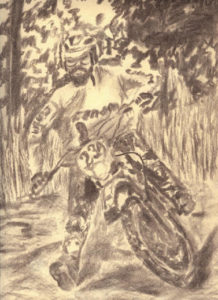 As a Court-Qualified Expert Witness and Safety Trainer, I’ve worked on over 75 legal cases and provided testimony regarding the operation of all-terrain vehicles -- ATVs, UTVs, snowmobiles, as well as motorcycle dirt bikes, dual sport cycles and street bikes, off-road guided tour injuries and related trail construction. I’m often asked by both plaintiff and defense attorneys to explain why and how frequently looking at and touching off-highway vehicles helps prevent off-highway vehicle accidents and injuries.
As a Court-Qualified Expert Witness and Safety Trainer, I’ve worked on over 75 legal cases and provided testimony regarding the operation of all-terrain vehicles -- ATVs, UTVs, snowmobiles, as well as motorcycle dirt bikes, dual sport cycles and street bikes, off-road guided tour injuries and related trail construction. I’m often asked by both plaintiff and defense attorneys to explain why and how frequently looking at and touching off-highway vehicles helps prevent off-highway vehicle accidents and injuries.
The video associated with this article provides helpful illustrations. When you view the third part of the 1973 International 6-Days Trials event held in Dalton, Massachusetts, notice how riders from many countries constantly look at, touch and clean their vehicles. Their intention is not to shine their machines up so they look good. They are more interested in the safety benefits of viewing their machines up close and personal.
By touching the vehicle’s parts and viewing them very closely on an ongoing basis, the operator becomes accustomed to what each machine part should look and feel like when it is operating correctly. Therefore, at the first indication of change, the operator / mechanic can make changes and adjustments to compensate for any change they notice.
Since it’s much more likely that their off-highway vehicles then operate well, this look and touch procedure significantly helps operators ensure their personal safety and enhance the safety of other operators around them. During competition, the preventive look and touch system also allows competitors to safely continue their journey to the finish line in each competition.
As an Off-Road Vehicle Safety Trainer, I highly recommend that both operators on the job and recreational riders adopt this process. My students often tell me after their safety training events that the simple procedures I showed them help them avoid becoming stranded or injured, whether they were operating an all-terrain vehicle -- ATV, UTV, snowmobile or a motorcycle dirt bike, dual sport motorcycle or a street bike.
Any type of technical breakdown can become a life-threatening event if the conditions are just right for a potential disaster to emerge. Therefore, I stress that you always be prepared to spend the night out, under whatever conditions exist during the time of year and location. I also remind my OHV Safety Training students that all operators and passengers need to have a working knowledge regarding how to use all survival equipment.
I’m often asked why every member of a group needs this knowledge. The answer is simple. If a group relies on one person to know everything the group members need to know, that sole individual may be the person who is hurt during an accident. Click here to read a related article.
Please note: Traction affects handling and handling effects the stability of a vehicle, which affects the operator’s personal safety. In the video related to this article, you’ll see riders constantly changing the tires on their motorcycles even when their tires are not completely worn out. This article explains more about how tire pressure is related to accidents and injuries.
Using this safety tip significantly enhances both the operator’s personal safety and the safety of other operators around them. This is because the operators can maintain control of their vehicle in a variety of conditions. See illustrations in the video, from mud and slop to nice moist soils that provide a high quality of traction to riding on an asphalt road in dry conditions, rain and fog. You won’t always be operating off-highway vehicles on a bright sunny day. In addition, conditions can change rapidly during different times of the year, like during spring and winter.
Whether I’m writing a report for an attorney, conducting a site visit, testifying in Court or training personnel for Military Special Forces, corporate or government organizations, one thing is similar. My job always includes analyzing safety conditions. I often accomplish this task by: (1) analyzing the smallest components that either increase or decrease safety and then (2) putting the components back together so the entire safety picture is available to all concerned, including attorneys, the judge and jury members.
The OHV operator safety focus I’m describing is a powerful fuel for training operators and instructors to ensure a safe riding experience and environment. Click here to view a related article and video about safety training. It also prepares me to serve as an Expert Witness regarding accidents related to the use of all-terrain vehicles, quads, 4-wheelers, (ATVs), utility vehicles (UTVs, side by sides, ROVs, RZRs), motorcycles of all types (dirt and street), snowmobiles, guided tours and related trail construction issues.
If we break down what it takes to keep your vehicle of choice in good working order to be safe, you will notice that the starting place is precise observation of the vehicle’s condition at every point in your journey. Because components of a machine fail in stages, not all at once, I advise vehicle operators / mechanics to consistently use precise observation of each and every component.
Prevention can omit not just accidents and injuries, but law suits, so catch potential problems as early as possible. You can also avoid being stranded, as well as many life-threating situations when weather and other conditions create extra challenges.
Here’s an example: When I taught an ATV operator’s class in Toke, Alaska area for the U.S. Coast Guard, in order to have enough vehicles so everyone in the class could have their own vehicle to ride, two of the students brought their personal vehicles to class to use. At one point during the class, I observed everyone’s ATV to make sure it was in good working order.
One of the students who had brought his personal vehicle to class had installed fancy aluminum wheels on his ATV. I noticed that some of the lug nuts were coming loose. At some point, the wheel would have fallen off. By the time the nuts had fallen all the way off and before the wheels came off, the nut would have been lost somewhere in nature, most likely never be seen again. I avoided this by observing his vehicle while we were talking. Because I discovered the loose nuts and asked the owner to re-tighten them, he avoided an accident that was waiting to happen.
Stop a moment now and consider another example, what could happen if you were traveling down a trail about 40 mph and you went over a small rise / jump in the trail. What if, as you un-weighted the wheel, your right front wheel decided to completely let go at that moment, causing the tire to fall completely off the ATV? What do you think the results could be?
Over decades of serving as an Off-highway Vehicle Safety Trainer, I’ve seen all kinds of situations about ready to create serious problems for the operators of all of the OHVs. I’ve been called on to conduct site visit after site visit to inspect the reasons tragic accidents occurred. Operators who were happy and healthy one moment unexpectedly became permanently disabled.
For these reasons, I implore you, as you journey on your vehicle of choice onto an established trail or into the wilds of nature, please take every opportunity to truly view and touch your vehicle’s parts. Develop a habit of observing and checking even minor parts, including when you’re resting during a ride or talking to other operators. Take a good look at your vehicle, as well as the machines other people are using. When we all cross check each other, many unnecessary accidents and injuries are avoided fairly easily. Go Slow To Go Fast, as you travel, while enjoying your time out!
NOTE: This article is not intended to be all inclusive. It is designed to provide a foundation for the reader to learn from.
Bill Uhl is a Safety Trainer and Court-Qualified Expert Witness for cases involving all-terrain vehicles (ATVs, quads, 4-wheelers), utility vehicles (UTVs / side by sides / RZRs, ROVs), snowmobiles, motorcycle dirt bikes, dual sport bikes and off-road bicycles trails. Uhl has completed over 75 cases while serving as an Expert Witness, including trial testimony. Click here for more information.
